After the 1978 Sabbatical
Most of our camping experiences occurred in the 1970’s but we started in 1969 after our return from the Philippines. We purchased a tent trailer and decided to try a campout on Thousand Islands. So we drove up there along with Nannette’s dog Zeus. The main thing we learned on this trip is that we will no longer travel with a dog.
In 1980 Ronald Reagan was elected President and he talked really well about how he was going to lead the country on the path to prosperity. He sounded fairly good until I heard him mention his plan to expand military spending beyond all belief by developing what he called a “Strategic Defense Initiative.” SDI. He tried to sell it as a defensive maneuver and even if that’s all that it was it violated treaties with the Soviet Union. These treaties outlawed an anti-missile defense system in the hopes of putting a lid on military spending for “Star Wars.” However SDI involved weapons to be used in space war – lasers to knock down incoming missiles for defensive purposes and also to destroy satellites for offensive purposes. So began decades of outrageous increases in military spending.
It became obvious to much of the faculty and student body at Syracuse University that the travesty of SDI should be addressed for what it is. A number of faculty created a committee to find if faculty in Engineering and Physics would publicly disavow any intention to accept R&D money to work on SDI. We felt it was important for those faculty members who could get SDI money to stand up and say they would refuse it. We felt that this was a valuable group to mobilize. We ended up getting some 35 faculty members to sign statement and literally hundreds of other members of the University community to also condemn “Star Wars”. We published the names of all these people in the campus newspaper, The Daily Orange.
The end of the decade of the 70’s saw us in the middle of Jimmy Carter’s presidency, and we were still in a travel mood. Ming Hu found ways for Sally and me, along with Ted and Frani Bickart, to travel some more. The four of us traveled to China in 1981, and that was so great that Sally and I worked our way back to China in 1984.
China 1981
Asia seems to be a defining land that has had a long-term impact on my life. Certainly this started because of the fact that the ECE Department at Syracuse University has a diverse faculty, with healthy communication between the faculty members and with the staff and students.
Two remarkable individuals in the Department were Yeuh-Ying Hu and Ming- Kwai Hu. Affectionately referred to as she-who and he-who. They found their way into the department in the early fifties via Taiwan. Since Ming’s English was very poor at that time, Yeuh-Ying was hired as a full time faculty member, and Ming was a Research Associate. As time went on they had two children, and lived nearby to campus.
My first years in the Department were spent in our Collendale campus, about a mile south of the main campus. I remember a terrible time when in the midst of a faculty meeting one Friday afternoon, Ming and Yeuh-Ying were called to the phone because of an emergency. Their youngest child had choked to death and the caregiver was absolutely disconsolate. The whole department was shocked and tried to console them in their loss.
As time went on, Ming and Yeuh-Ying asked that their appointments be switched. Ming was more the all-around faculty member, and Yeuh-Ying wanted to concentrate on her teaching. The switch occurred and Ming became the Full Professor, and Yeuh-Ying became a Research Professor. This happened because of a University policy at that time that spouses could not both be faculty members. This occurred in the early 1970’s. Later in that decade enrollments were falling, and the Department Chairman, Wilbur Lepage, came to the belief that the department no longer had the funds to support Yeuh-Ying, and decided to not reappoint her to her position as Research Professor. This devastated Yeuh-Ying as she was a most dedicated teacher, and poured herself into her classes. Don Kibbey, Chairman of the Mathematics Department, stepped in and found the money to hire her. In addition she fought the decision to let her go from the ECE Department. It turned out that she had been teaching for well over the seven years needed for tenure, and she had never had a tenure review. With the involvement of the local chapter of the AAUP she regained her full-time non-faculty position in the ECE Department.
I took a graduate level course from Yeuh-Ying – a course in Electromagnetic Theory. This was her main field of interest and just the opposite for me. One time she gave a quiz to the class, and we all did quite poorly. She was very upset by this, and after returning the quizzes to us she then had us take the same quiz over again. Our marks improved somewhat, but still were not so hot.
During this time mainland China was under the control of Mao Tse-tung, and in 1966 he started what he called a Cultural Revolution. One part of this plan was that University faculty members were taken out of the schools and sent into the countryside to work as laborers. However, with the death of Mao Tse-tung in 1976 the Cultural Revolution came to an end and reconstruction started. Under the leadership of Deng Xiaoping the academic community was reunited, but the faculty members were woefully out of date. So China started a program wherein Chinese faculty members were sent as Visiting Scholars to Engineering Colleges around the world. Syracuse University participated in this and received several such Scholars. I ended up having two such Scholars working with me.
Ming Hu had graduated from the University of Nanjing and had made his way to Taiwan in 1949 when Mao took over the mainland. With the end of the Cultural Revolution Ming renewed his contacts in Nanjing, and made a trip to China in 1979 to discuss how he could help his former colleagues. Upon his return to Syracuse he explored this further with Ted Bickart and me, and asked us if we would like to go to China for a few months during the summer and teach courses to faculty members there. The school Ming had graduated from had been renamed the Nanjing Institute of Technology, NIT. Ted and I both jumped at the chance. We decided that I would teach a course on digital computer operation and Ted would teach a course on digital computer design. The Chinese asked that I bring a computer with me, and so I purchased a TRS-80. Also they wanted some computer chips, such as CPU’s and memory chips.
The arrangements were completed in the spring of 1981, and we left in early June of that year. Sally and I felt completely free then, as Jim was married and had left home, while Mark & Nannette were fully occupied with their lives while still living at 212 Standish Drive. Ted Bickart and Frani Cumming were also ready, but they decided that they would both use the Bickart last name since Ted wasn’t sure how the Chinese would view their situation. Ted came over to China first with Sally and me, and then a month later Frani flew in to Shanghai and joined us.
The Chinese indicated that they would pay us 10 rmb (about 3 or 4 dollars) per day for our teaching, pay for all travel expenses, supply us with food and lodging while in China. Also each weekend we would tour around Nanjing and then the real plum – take us on a 2-week guided tour of China upon conclusion of the teaching work.
So, we gathered together all our equipment and began making our arrangements to get to Nanjing. We were to leave from JFK early in the morning so we rented a car and got all our suitcases and the equipment into it. We spent a night on the road and then the next morning got ourselves to JFK airport in New York City. The three of us flew non-stop to Shanghai on the carrier CAAC. We arrived there in late evening, and with a lot of hand waving and struggling with our language differences we got everything through Customs. That previous sentence tells you that no one from NIT was there to meet us. So there we were- three “round-eyes”, a pile of equipment and suitcases, and apparently no place to go. The weather was quite warm, but we were exhausted from the 20-hour flight, and had no desire to sleep in the terminal.
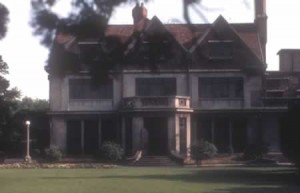 The people in the airport saw our plight, and directed us to a tourist aid office just around the corner from the terminal building. We tried calling NIT, but it was late at night, so no contact was made. Then the tourist aid people got to work and made arrangements to put us up at a very special house that used to be the home of a US banker. It was called the Xing Gou Guest House. The place was extremely well appointed with linens and silver services. We had a fine sleep, and we were served breakfast in a formal dining room. By late morning NIT had been contacted by someone, and shortly a Mr. Wong showed up. He was from NIT, our school in Nanjing, and was supposed to have met us at the airport. Later we learned he used the excuse that things got screwed up as people didn’t account for the date change because of the International Date Line that we crossed. Mr. Wong also spoke no English, but a Mr. Yin, Da-lu also arrived and was to be our guide in Shanghai. He also spoke little English, but accompanied us to our hotel, the Jing Jang hotel. Then he took us on a tour of Shanghai. We walked along the Bund and visited the Shanghai Industrial Exhibition. The next day we were shepherded to the train station, along with our luggage, and then we were on our merry way to Nanjing. After he delivered us to Nanjing we never saw Mr. Wong again.
The people in the airport saw our plight, and directed us to a tourist aid office just around the corner from the terminal building. We tried calling NIT, but it was late at night, so no contact was made. Then the tourist aid people got to work and made arrangements to put us up at a very special house that used to be the home of a US banker. It was called the Xing Gou Guest House. The place was extremely well appointed with linens and silver services. We had a fine sleep, and we were served breakfast in a formal dining room. By late morning NIT had been contacted by someone, and shortly a Mr. Wong showed up. He was from NIT, our school in Nanjing, and was supposed to have met us at the airport. Later we learned he used the excuse that things got screwed up as people didn’t account for the date change because of the International Date Line that we crossed. Mr. Wong also spoke no English, but a Mr. Yin, Da-lu also arrived and was to be our guide in Shanghai. He also spoke little English, but accompanied us to our hotel, the Jing Jang hotel. Then he took us on a tour of Shanghai. We walked along the Bund and visited the Shanghai Industrial Exhibition. The next day we were shepherded to the train station, along with our luggage, and then we were on our merry way to Nanjing. After he delivered us to Nanjing we never saw Mr. Wong again.
 The train ride was very pleasant, and we got a chance to recover a little from our jet lag on the way to Nanjing. The land was being farmed up to within a row of trees of the railroad tracks, and loads of irrigation projects were underway. The greatest product was rice, and there was so much of it, it looked as though there was no room for weeds.
The train ride was very pleasant, and we got a chance to recover a little from our jet lag on the way to Nanjing. The land was being farmed up to within a row of trees of the railroad tracks, and loads of irrigation projects were underway. The greatest product was rice, and there was so much of it, it looked as though there was no room for weeds.
We arrived in Nanjing around dinner time, but again there was no delegation there to meet us. We were finding that the overall event moves along OK, but the details were missing. Finally the group from NIT showed up, and they took us to our hotel. It was old and the rooms rather shabby. We had a decent dinner, took a little walk, and called it quits for the day.
The next morning we again went for a walk, to see what China is like! We had been able to exchange some US dollars for Chinese foreign exchange currency, but this is useless except in the Chinese State run stores-so called Friendship stores. We wanted to buy some little things from local merchants but they would only accept the local money, called rmb. As we walked along students would come up to us and ask, in English, if they could walk with us. We were delighted at this and found that they study English through TV programs, and wanted to practice their conversational skills with us.
That night after supper we were taken to Peking Opera by a Mr. Song. He is an English teacher at NIT, and will serve as Ted’s interpreter. The opera was great. Quite a production: flamboyant costumes, singing, mime, and acrobatics. Some of the actors were fitted with huge “white eyebrows”. We of course didn’t know what the opera was about, and found ourselves getting extremely sleepy. Still struggling with jet-lag.
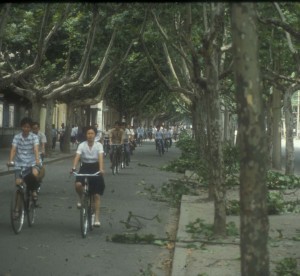 The next day we started our teaching. We were shuttled by a car and driver from NIT, and we made two round trips each teaching day. Our driver was particularly gas conscious, and whenever he could he would shut off the engine and let it coast. He must have made about 30 restarts of the engine each trip. The major streets in Nanjing are very broad, partly because they include about two 20-foot wide bicycle lanes, one going in each direction. In addition there were two lanes in each direction for automobile traffic and also two trolley tracks. We arrived in Nanjing in June and the weather seemed unbearably hot. Nanjing is known as one of the three furnaces of China – the other two being Wuhan and Chongqing, all situated on the Yangtze River. The intense heat of the sun was made quite bearable by the Sycamore, or plane, trees that line the streets. These trees are managed carefully and their huge branches stretch out over the street and supply shade to the perspiring citizens.
The next day we started our teaching. We were shuttled by a car and driver from NIT, and we made two round trips each teaching day. Our driver was particularly gas conscious, and whenever he could he would shut off the engine and let it coast. He must have made about 30 restarts of the engine each trip. The major streets in Nanjing are very broad, partly because they include about two 20-foot wide bicycle lanes, one going in each direction. In addition there were two lanes in each direction for automobile traffic and also two trolley tracks. We arrived in Nanjing in June and the weather seemed unbearably hot. Nanjing is known as one of the three furnaces of China – the other two being Wuhan and Chongqing, all situated on the Yangtze River. The intense heat of the sun was made quite bearable by the Sycamore, or plane, trees that line the streets. These trees are managed carefully and their huge branches stretch out over the street and supply shade to the perspiring citizens.
And perspire they do. One of the most noticeable features in the city is the vast number of bicycles. Just about everyone seems to be riding a bicycle, and there are vast bicycle parking lots scattered about with the bikes seemingly almost piled on top of one another. I often wondered how anyone could find their bike – it seems all Chinese bikes look alike!
Of course the three of us, and later when Frani joined us the four of us, were treated royally by our Chinese hosts. There were banquets and celebrations of all kinds and we were made to feel most welcome.
Our teaching experience was exciting, and certainly very different. Ted and I each taught a class of about 30 students, and we each had a translator who would speak to the class in Chinese. Most of the students were older faculty members who had been taken out of the academic life during the Cultural Revolution. The rest were young students at NIT. The older faculty members were very quiet and respectful and would not ask questions. The young students wanted to interact with us as much as they could. The way we taught was essentially to teach our translator, and then the translator would tell the class what we said. Sort of. Ted’s translator was a teacher of English, while mine was an engineering faculty member whose English was rather limited.
Ted really had the worse time of it. While his translator knew English, he did not know technical jargon. And there is a lot of that in Computer-speak. How could such a person translate a sentence like “boot up a machine”? The translation was not simply a word for word transliteration, but rather it had to be by paragraphs. My translator, his name was Xing, Wan-Chun, knew the material I was teaching, but was worried sick about studying his English so that he could tell the students what I said. The poor man had great difficulty sleeping at night, he told me, because of his concerns to do a good job.
 The picture shows the primary characters in this expedition. Left to right there is Frani Cumming, Ted Bickart, Prof. Wong the president of NIT, myself, Sally, Song who was Ted’s translator, and Xing my translator.
The picture shows the primary characters in this expedition. Left to right there is Frani Cumming, Ted Bickart, Prof. Wong the president of NIT, myself, Sally, Song who was Ted’s translator, and Xing my translator.
We proceeded through our courses, and everyone was pleased at what was happening. When we weren’t teaching we did sight-seeing around Nanjing. One time we walked up to the Yangtze River, about 2 miles from our hotel. It was horribly dirty, as its most remarkable feature. We found that the walk was longer than anticipated because of the heat. So, we took a bus back to the hotel. It cost us 15 fen each, about US 2 cents. In this region the Yangtze is a major border in the following sense. In the winter time the residents north of the river could have central heating in their homes and businesses, while south of the river they could not. Nanjing is south of the Yangtze, and the winters there must be dreadful.
I must point out something about Chinese names. There are really very few different family names, especially for a country of more than 1 billion people. However the names really only sound alike – they have different characters representing the sound. So, when two Chinese people meet and introduce themselves it isn’t just a matter of saying the name. They will each sketch out the character of their name, using the index finger of one hand and the other open palm as the drawing board. So, you will see there are many Wong’s mentioned in this paper, but they are not related.
We often had trouble communicating with our Chinese friends. We inquired about the various markets around and we were told: “You should visit the flea market – they have many things for sale there.” Well, we thought that was fantastic, that they had the same kind of description for a market as we had. So we got directions on how to find it and off we went. When we got there we found that they really meant: “free market.” This is a common problem in pronunciation, and we just had to be careful. Incidentally the fact that there was a free market was an indication that the controls were easing up. The farmers had one day a week when they could sell their produce and keep the money for themselves.
Sally was approached by the NIT administration and invited to have conversational English sessions with numbers of young students preparing to go overseas. Of course she was delighted to do this, and they offered to pay her 200 yuan for her time. She had a great time with this and carried them through situations they could encounter in the airports, at customs, and the like. Shortly after this was payday. Ted and I each got 400 yuan, and Sally received 100 yuan. Our first Chinese paychecks. And this is in rmb, so we could go out to the markets and spend it! One of the things we bought was a pin-jing plant.
We visited many parks around Nanjing, and each one more spectacular than the others. One day we went to the Taiping Heavenly Kingdom Museum. We found that the intricacies of a Chinese garden are always part of an overall building plan. In the one we saw the stone sculpture was brought from a quarry near Szuchow and cemented into an intricate design with a pool.
Each face of the stone presents a different scene. In order to be correct the stone must 1) be attractive, 2) be thin, 3) have a good surface and 4) have holes in it. Nothing is simple in China.
We discussed with Mr. Song some of the things that went on during the Cultural Revolution. He had been persecuted – he spent over 2 years in a basic living condition- a hut with no water or electricity-as he planted crops on a farm. He said: “If one owned a fruit tree the farmers would cut it down claiming you are a capitalist to own a tree.” Farm machinery was hard to come by, and as a result food production was down.
It was interesting to note what happened on July 1. This was the 60th anniversary of the communist party in China. The campus was deserted and there were many TV sets that could be heard in the distance. There was a speech being given by the newly appointed head of the Communist Party and everyone wanted to hear and see it.
We were exposed to the details of Chinese bureaucracy from time to time. For example, when we wanted to be driven somewhere the request is put on a list. When it reaches the top then it goes down a list of drivers. Thus it can take a long time for the request to be acted on. The drivers are quite insistent that we don’t stay long anyplace we go. If we exceed their expected time they are very rude to us when we return, and sometimes they drive like maniacs when they are angry. One time we were in a little café having a cup of tea and our driver appeared at the window! He was furious. We left immediately and he drove back to the hotel like a madman. No one can be fired from a job, of course, so everyone is exposed to this treatment from service oriented workers. It was always a scary adventure to ride in the chauffeured cars. Some of them were left-hand drive having been supplied by a low bidder from Australia. The normal driving lane is to the right and whenever we passed another car, successfully it was a huge WOW of an experience.
In the hotel there are floor boys who keep the rooms cleaned, water buckets filled, and the like. Their English was spoken with a British accent and when ever we said “Thank You” they would respond with “notatall.” It took us some time to realize they were saying – “not at all.” They all play Chinese Chess, so I asked them to show me how. I never became very good at it, but I bought a set of my own. Sally and I would go wandering around doing shopping, and so I bought a nice set in a local shop. We would go with our little English-Chinese dictionary and work it out with the store clerks. We were always treated in a most friendly fashion, and never felt any fear while out walking after dark.
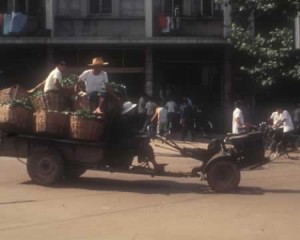 The streets were always filled with activity – bicycle riders, walkers, a few cars, animal driven carts, and the like. One very common vehicle is known as a su-fu-tu-lar-gee. I felt very proud when I realized that I now knew a 5 syllable word in Chinese! This is a picture of that remarkable vehicle. The engine is way out in front, and a cart is attached to it. It is a vehicle used mainly on farms.
The streets were always filled with activity – bicycle riders, walkers, a few cars, animal driven carts, and the like. One very common vehicle is known as a su-fu-tu-lar-gee. I felt very proud when I realized that I now knew a 5 syllable word in Chinese! This is a picture of that remarkable vehicle. The engine is way out in front, and a cart is attached to it. It is a vehicle used mainly on farms.
There was man from Canada that lived in the same hotel as we did, and I talked with him about why he was here. It turns out that he was with a distribution company in Canada and he was in China to see if it is possible to buy Chinese made clothing. He indicated that China has a long way to go before they will be ready to sell manufactured goods. He said they have almost no quality control and that must be upgraded before they can compete on the international market. One time I went to visit a plant where cloth was made and their weaving machines were still controlled by punch cards. This results in very slow operation and tedious methods to change a design.
We also met a Syracuse University faculty member of Chinese descent who was here to give some lectures. We shared our thoughts about our students both here and back home and he had some interesting comments to make. American students were not really reliable-too many conflicting interests. Students from India were troublesome because of caste differences. Chinese students did exactly what they were told, but were not innovative at all. I saw examples of this when I visited an electrical engineering laboratory at NIT. The students were all busily wiring printed circuit boards that had hundreds of wires to be soldered in. Their work was beautiful to behold, but was hardly a reasonable activity for an engineering laboratory!
In early July Frani arrived and we all continued with our sightseeing. Many temples, museums and the like all had to be investigated. Included in this was Chou En-Lai’s home – of European design. One of the Visiting Scholars in Syracuse is a man by the name of Jai (pronounced jaw), and on our second trip to China we visited his father-in-law. This is a remarkable person in that he owned his own house, and lived in it throughout the entire Cultural Revolution. He undoubtedly had some very powerful connections. Jai’s wife was still living in China at the time, along with their twin sons. Eventually these twins ended up coming to Syracuse University and one of them was a student in a graduate course I taught.
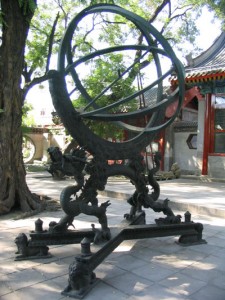 One weekend we went to the Purple Mountain Observatory. The ancient astrological instruments were simply beautiful. One was an armillary sphere. This instrument had an arrangement of rings to show the relative positions of the ecliptic and the celestial equator. We were told that some emperors didn’t like science and preferred art. Thus the only way to have scientific instruments was to have them appear to be art pieces.
One weekend we went to the Purple Mountain Observatory. The ancient astrological instruments were simply beautiful. One was an armillary sphere. This instrument had an arrangement of rings to show the relative positions of the ecliptic and the celestial equator. We were told that some emperors didn’t like science and preferred art. Thus the only way to have scientific instruments was to have them appear to be art pieces.
It seems that everything we wanted to visit was at the end of a long walkway and then at the top of an interminable flight of stairs. One example of this is the Sun Yat Sen Memorial. As seen in the next picture the memorial is at the top of a significant flight of stairs, and we had to walk nearly ½ mile to get to it. Of course it was great to see it, but one had to pay a price!
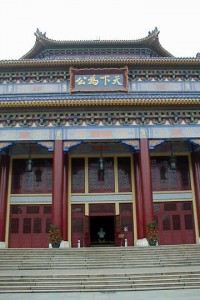 There are 13 tombs to the emperors named Ming, and all but one of them are in Beijing. The tomb of the first Ming emperor is in Nanjing, and one weekend we went to visit it. The long walkway
There are 13 tombs to the emperors named Ming, and all but one of them are in Beijing. The tomb of the first Ming emperor is in Nanjing, and one weekend we went to visit it. The long walkway to it was lined with stone statues of various animals. As we walked along we encountered other visitors and they had found some soda to drink. So we looked around and found a small stand where it was being sold. We bought a bottle of each of us, since the heat was devastating. It tasted so bad we could not swallow it even in our desperate straits. We henceforward referred to it as “tomb water.”
to it was lined with stone statues of various animals. As we walked along we encountered other visitors and they had found some soda to drink. So we looked around and found a small stand where it was being sold. We bought a bottle of each of us, since the heat was devastating. It tasted so bad we could not swallow it even in our desperate straits. We henceforward referred to it as “tomb water.”
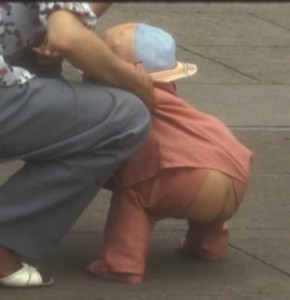 We also saw many mothers out airing their children, and here is a typical example. Not much need for diapers. Our guide at this time was a single lady, and her English was quite poor. Whenever we saw something we liked, she would say “Want to Buy?” So, we nicknamed her Miss Want to Buy?
We also saw many mothers out airing their children, and here is a typical example. Not much need for diapers. Our guide at this time was a single lady, and her English was quite poor. Whenever we saw something we liked, she would say “Want to Buy?” So, we nicknamed her Miss Want to Buy?
Our tour of duty in Nanjing was drawing to a close, so there was a round of banquets to wish us well. Ted and I gave our final classes and the students were quite demonstrative in their thanks. Of course one doesn’t know how much of this was student inspired or Administration inspired.
Before we left Nanjing we did some sponsored sight-seeing around the metropolitan area. One place we visited was Ji Xia (Perch of the Rosy Cloud) to see the 1000 Buddhas. As we entered the area we saw a pagoda in a small pond. It was accessed by a zig-zag bridge but the last section had fallen in. (An hour later we left by the same path and saw that the entire pagoda had collapsed!) We walked for about an hour and reached the Buddhas. Indeed there were very many of them, but a lot of them had been destroyed or damaged by the Red Guard during the Cultural Revolution.
When we returned to Nanjing our guide said he could take us to a school for the blind. This really intrigued Sally and so we readily agreed to go there. There were not any students that we could meet since classes weren’t in session. However two teachers were there and Sally talked with them about their students and the way in which they prepared Braille texts for them. The school we visited was started in 1927 with 5 students. At the time of our visit the school had 56 students. In all we had a very interesting and friendly visit with the teachers.
As a little aside, it is somewhat difficult to create a Braille version of a text written in Chinese. There are only 64 different 6-dot Braille cells and yet literally thousands of Chinese characters. So, first one must know the pinyin for the character and then Braille the pinyin. Pinyin is a system of phonemic notation and transcription to Roman, where pin means “spell” and yin means “sound”. The work is further complicated by the fact that Chinese is a tonal language and that the meaning of the pinyin depends upon whether the sound is rising or held even or falling. The Chinese word for braille is “mong wun’ which means blind words. The code was developed in 1952 by a certain Huang, Le Lu, the Vice Chairman of Education of Blind Children in China.
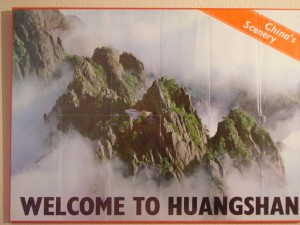 In mid-July we sarted on a new adventure. This one sticks strongly in my mind. Early in the morning we started the trip to Huang-Shan Mountain, supposedly about a 7 hour drive from Nanjing. The van started overheating and not only did that mean many stops to let it cool off, but the interior of the van became almost unbearably hot. In all it took 13 hours. About 7:30 the next morning we started the climb up the mountain to a hotel on the top.
In mid-July we sarted on a new adventure. This one sticks strongly in my mind. Early in the morning we started the trip to Huang-Shan Mountain, supposedly about a 7 hour drive from Nanjing. The van started overheating and not only did that mean many stops to let it cool off, but the interior of the van became almost unbearably hot. In all it took 13 hours. About 7:30 the next morning we started the climb up the mountain to a hotel on the top.
We were told it was about 7 kilometers to the top and required climbing 4,444 steps. The pain in our legs became severe and required that we stop often to rest. We were passed by porters carrying food and construction materials up these same steps. They carried the material at each end of a pole about 10 feet long, and rested the pole on one shoulder. We were told they were paid 3.50 yuan for each 110 pounds they carried. This required a very special way of walking to keep the material from starting to swing. It looked horrible! The scenery was absolutely beautiful, even when viewed through a fatigued and pain filled body! Sally developed a cramp in her leg, and our guide cured it with acupressure. Frani was not so fortunate. She too developed terrible leg pains and the guide told her he would push back the cuticle on her thumb, and that would cure the pain. We watched as he did this and it looked awesome. When he finished we asked Frani if it helped and she cried: “I don’t know, my thumb hurts so much I can’t tell if my leg still does!” At one rest stop Ted noticed there was a path leading off to the side. He wanted to explore it and we three laughed him to scorn when he asked if anyone would join him. So he went alone, and when he returned he informed us that we had just missed seeing the best view of the trip! To this day I hate him with a passion for that remark!
We arrived at the summit hotel late in the day, and were treated to a fantastic sunset. The next morning we were up early to watch the sunrise at 5:00 a.m. and again were astounded by the sight. This followed the eagerly-anticipated showers. There was one shower room for men and another for women. Frani and Sally dashed immediately to the women’s shower room, which was full of naked Chinese women waiting for something, but we couldn’t tell what. Frani impatiently headed to a shower and turned it on, to discover that they were waiting for the hot water to be turned on…scheduled to happen in a few minutes! She cooled down in a hurry!
Our breakfast — one of the few Chinese breakfasts we had on the trip — included a thin gruel plus peas and peanuts (both difficult to eat with chopsticks). (In our Nanjing hotel, we were served American breakfasts but Chinese food for the other meals.) It was freezing cold outside, but the hotel supplied us with overcoats. We then rested for a short time and started the descent. This was much worse than the ascent.
I find it hard to describe how it felt, as it brings back so much feeling of pain. The first hour or so wasn’t too bad, since I didn’t have to lift any weight. However, the steps were usually of stone or some other hard material, so at each step I had to bring the down movement of my body to a halt. Even now my knees ache at the memory. This went on for 2 ½ hours, with each step more painful than the previous one. We stopped often, but that only delayed the resumption of pain. I distinctly remember at one point feeling: “I cannot take another step!” However, we rounded a bend and there was the exit of the trail! I don’t believe I’ve ever hurt so much for so long a time.
The ride back to Nanjing was as expected – four different break downs. First the brakes went, a couple of times there was over heating, and once a bolt flew off the engine and into the battery pack. Many sparks flew but our trusty driver fixed that also. But the ride was nevertheless interesting. At one break down point we met a little nine year old girl. She had never seen a stranger before and also didn’t know if our Chinese guide was a foreigner or not since he spoke a different dialect. Although strangers were unfamiliar to her, she accepted our hard candies and gave us some apples. She told us, upon questioning, that she did not go to school but that her brother did. However, she said, he was suffering from cancer. She asked if we could help him.
 Our next trip was to Xian to view the terra-cotta figures that were being excavated. In 1974 some farmers digging a well came across a figure, and subsequently it was found that there are over 6,400 life size figures of warriors and horses all protecting a tomb. No two figures have the same features. The figures are in a large field covered over by a roof. Many figures were damaged when a roof collapsed, but they have all been repaired. The emperor whose tomb is the one being guarded is the person who unified the language, the system of measurement, the width of cart tracks and created the “Great Wall.” However, he also ordered all the people who made the figures to be killed. We also visited a museum at the site, and found a fascinating wall hanging. It appeared to be a bamboo tree, but upon closer inspection it is seen that the leaves of the tree are such that they form Chinese characters. Xing, our guide, was fascinated by it and said the characters are of ancient form. He said the message is one of protest against the Emperor but the artist hid the figures in the bamboo tree.
Our next trip was to Xian to view the terra-cotta figures that were being excavated. In 1974 some farmers digging a well came across a figure, and subsequently it was found that there are over 6,400 life size figures of warriors and horses all protecting a tomb. No two figures have the same features. The figures are in a large field covered over by a roof. Many figures were damaged when a roof collapsed, but they have all been repaired. The emperor whose tomb is the one being guarded is the person who unified the language, the system of measurement, the width of cart tracks and created the “Great Wall.” However, he also ordered all the people who made the figures to be killed. We also visited a museum at the site, and found a fascinating wall hanging. It appeared to be a bamboo tree, but upon closer inspection it is seen that the leaves of the tree are such that they form Chinese characters. Xing, our guide, was fascinated by it and said the characters are of ancient form. He said the message is one of protest against the Emperor but the artist hid the figures in the bamboo tree.
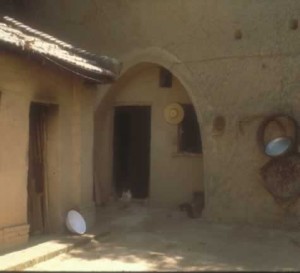 On the way back to the hotel we drove by a cave house, as shown here. We stopped in to visit and were hospitably received by the woman of the house. She showed us her home, and was very excited to meet the “merigoes.”
On the way back to the hotel we drove by a cave house, as shown here. We stopped in to visit and were hospitably received by the woman of the house. She showed us her home, and was very excited to meet the “merigoes.”
Our next stop was Beijing. Of course we toured the Forbidden City, and then roamed around Tiananmen Square. I watched some men flying kites. They attached ornate notes to the string and sent them up to the kite.
In the afternoon we went to the “Great Wall.” (Actually the Chinese words for the wall translate to “Long Wall”.) It is impressive, especially when one realizes that this is the only man-made object that can be seen from the moon.
A little later we went to see an Arts & Crafts factory. We saw people working on jade figures – one man said he had been working on one figure for three years. We saw people working on ivory, cloisonné and sculptured lacquer ware. In all seven different crafts were made here, including painting on the inside of small bottles.
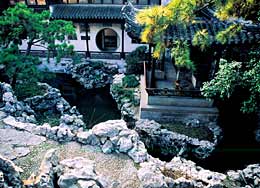 We then flew to Shanghai and the next morning took a train to Suzhou. This is known as the city of gardens, and at one point we visited the smallest, called the Fisherman’s Net. It has an intricate structure of aisles, doors, water, bridges and the like so that even though it is less than 100 yards square it seems to be immense. After we had lunch we went to another garden, called The Garden of Lingering. It seems almost endless the number of different things to see and marvel at. Suzhou is also known for its beautiful women, beautiful dialect, and incredible double-sided embroidery, which we saw being made. The young women making it were fabulous artists. We were told that they could work on it for only a few years before their eyesight would deteriorate too much.
We then flew to Shanghai and the next morning took a train to Suzhou. This is known as the city of gardens, and at one point we visited the smallest, called the Fisherman’s Net. It has an intricate structure of aisles, doors, water, bridges and the like so that even though it is less than 100 yards square it seems to be immense. After we had lunch we went to another garden, called The Garden of Lingering. It seems almost endless the number of different things to see and marvel at. Suzhou is also known for its beautiful women, beautiful dialect, and incredible double-sided embroidery, which we saw being made. The young women making it were fabulous artists. We were told that they could work on it for only a few years before their eyesight would deteriorate too much.
All this time Xing and his 19-year-old daughter, who was studying English, were traveling with us, and we became quite close in our friendship. But, finally the day came where we were to leave the next morning. We were to fly to Guangzhou, (Canton) the next morning and that might be the last we see of him. He accompanied us to the airport and we gave him a “Beautiful New York” book and a cloisonné ashtray. Xing said: “I feel many things inside me but I do not have words for you.” We were all a little blue at leaving each other. (Later Xing came to Syracuse University as a Visiting Scholar and worked with me.)
When we arrived in Guangzhou we were met by a guide. He took us to our hotel and then started visiting more factories. This included a porcelain factory and a fan factory. Again everything was made by hand. We spent a couple of days in Guangzhou and then said goodbye to China and boarded a train to Hong Kong. Two guards were stationed in the rear of our car, and when we arrived at the border the guards were changed. Hong Kong guards took over. The border was marked by a barbed wire fence. The picture shows the fence viewed from the Hong Kong side. We are now in The New Territories, and the change from 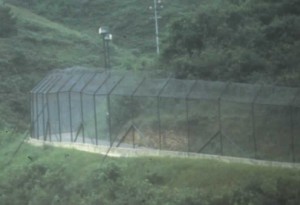 China is amazing! Construction cranes everywhere. It is about 35 miles to Hong Kong. The lease from China for Hong Kong is up in 1997 – about 16 more years – and nobody seems to be bothered by that since the construction seems to be going on everywhere.
China is amazing! Construction cranes everywhere. It is about 35 miles to Hong Kong. The lease from China for Hong Kong is up in 1997 – about 16 more years – and nobody seems to be bothered by that since the construction seems to be going on everywhere.
 When we arrived in Kowloon we said goodbye to Ted and Frani since they were going to stay with friends. We then went to check on our room. We thought we had a reservation at the “Y”, but nothing was recorded. However we were able to rent a suite for $50 a night, and it was most comfortable. After lunch we took the Star Ferry over to Hong Kong and again were amazed at how much it has changed from our trip in 1967 when we had stopped on our way to the Philippines. New construction was everywhere, and now 5 million people are living here. We took a bus tour of Hong Kong and visited the Tiger Balm Gardens, went to the top of Victoria Peak and passed by the ladder street. But we had been doing so much sight seeing in the past few weeks that we felt rather jaded and called it a day. We took the Star Ferry back to Kowloon and settled into our hotel rooms.
When we arrived in Kowloon we said goodbye to Ted and Frani since they were going to stay with friends. We then went to check on our room. We thought we had a reservation at the “Y”, but nothing was recorded. However we were able to rent a suite for $50 a night, and it was most comfortable. After lunch we took the Star Ferry over to Hong Kong and again were amazed at how much it has changed from our trip in 1967 when we had stopped on our way to the Philippines. New construction was everywhere, and now 5 million people are living here. We took a bus tour of Hong Kong and visited the Tiger Balm Gardens, went to the top of Victoria Peak and passed by the ladder street. But we had been doing so much sight seeing in the past few weeks that we felt rather jaded and called it a day. We took the Star Ferry back to Kowloon and settled into our hotel rooms.
The next day we flew to Manila and renewed our contacts with old friends there. After a full day of that we flew on to Cebu. Just by chance we met Rey Crystal on the plane so Sally and Rey had a chance to bring each other up to date on what has happened over the past 2 years. The Cebu Braille Center is still functioning well, and growing.
At Cebu a whole crew from the University of San Carlos met us. They had a ½ dozen of red roses for Sally and a big “Welcome John and Sally” sign on the truck. We had been supplied rooms at Girls High School for the duration of our stay, and that was quite convenient. We spent the day visiting old friends, including Fr. Salazar and other priests in the Administration building.
The next day Sally visited the Ministry of Education and the Cebu Braille Center, and of course had a joyous reunion. All three braillists are still employed at the Center. Six blind children have been integrated into regular classes in the Cebu State College, and one student is an Honor Student. During our stay in Cebu I gave several seminars dealing with modern Computer Engineering education, education in China, and such topics. We traveled to Leyte again, and I gave another seminar in Tacloban this time on the topic: “The use of microcomputers in Education and Business.”
By mid August we finally ended our excursions around the Philippines and flew back to Manila and thence to Syracuse. Since our reservations from Manila to Syracuse had been fouled up we ended up buying Business Class tickets and this is a most comfortable way to spend the next 20 hours.
The past three months have been filled with new experiences and renewing old relationships, and we are overwhelmed with feelings of joy and fulfillment. We are so fortunate.
 Around this time we started to have anniversary celebrations. Our first big one was for our 35th wedding anniversary, in 1982. We bid upon the services of a favorite band – the Cranberry Lake group composed of a washtub base, a guitar, a mandolin. a singer and a ukelele. We held the celebration in our back yard and invited all the friends we could think of. Here is a picture taken at this first one, of Sally, Rachel, and Dolores Morgan. A great time was had by all and included square dancing and such activities. We did this every five years through our 50th anniversary celebration in 1997.
Around this time we started to have anniversary celebrations. Our first big one was for our 35th wedding anniversary, in 1982. We bid upon the services of a favorite band – the Cranberry Lake group composed of a washtub base, a guitar, a mandolin. a singer and a ukelele. We held the celebration in our back yard and invited all the friends we could think of. Here is a picture taken at this first one, of Sally, Rachel, and Dolores Morgan. A great time was had by all and included square dancing and such activities. We did this every five years through our 50th anniversary celebration in 1997.
China 1984
Ever since we returned to Syracuse in August of 1981 I have felt the urge to go back to the far East – in particular to return to China and the Philippines. There are so many reasons for this. Part certainly is the excitement of seeing something new, and possibly making it a part of my life. For the Philippines it also involves the large number of friends we have there. But the mystique of the Orient grows on me also. So in the later part of 1983 I talked again with Ming Hu about the possibility of going back to China. I told him how I was now teaching a new course in robotics, and had found a small robot that is very useful as a teaching tool. I use it in courses on the main campus and off campus in Poughkeepsie and suggested to him that perhaps some schools in China might be interested in it also.
I also stayed in contact with the University of San Carlos in Cebu City, and the Engineering College there, through Dennis Bermejo the head of the ECE Department, and he indicated they wanted a robot. Ming pursued the suggestion of considering China and we worked out a rather remarkable plan. Sally and I would be supported to teach at three different schools in China, with side trips to two more. We agreed to go first to Chongqing University (Chungking), then to Nanjing Institute of Technology, and then the Beijing Institute of Astronautics and Aeronautics (BIAA). I would also give seminars at the Chengdu School of Radio and Electronics and finally the Post and Telecommunications Institute in Chongqing. For this work they would cover the airfare and living expenses for Sally and me in China, supply us with local touring each weekend, and then another 10 days or so after the teaching activities. Of course they would also cover the trip down the Yangtze from Chongqing to Nanjing. To round out the trip we decided to stop in the Philippines for 10 days or so and deliver a few lectures along with the robot to the University of San Carlos. Altogether we would be gone a little over 3 months.
So, we left the US in early May and planned on returning in mid August. I brought the robot for Chongqing with me, and had the company, Rhino Robots, send one each to Nanjing and Cebu City. I will be reimbursed for these as the trip goes along. We have a lot of baggage to take with us, so we decided to rent a van for a one-way drive to JFK Airport. Our friends Joyce and Sid Goldstein live near to New York City so we will drive that far, spend the night with them, and finish off the trip the following morning.
This time the trip turned out to be smooth and without hassles. On the flight Sally and I decided to each have a Manhattan cocktail but the stewardess didn’t know how to make one, so she supplied us with all the makings. Other people wanted mixed drinks also, and they too received bottles full of the mixings. It was a very jolly crowd on that plane.
Twenty nine hours after leaving JFK we finally deplaned in Beijing and got to our bed in the hotel at 11:15 p.m. Friday, May 4. People met us at the airport and we had no trouble with customs or hooking up with our guide. The next day we met our contacts from the BIAA and they asked me to order 3 more Rhino Robots to be delivered to their contact in Detroit and they will bring them to China. Too bad I didn’t foresee this and set up a contract with Rhino!
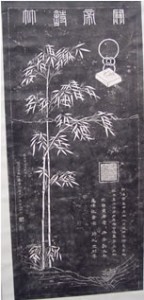 We started this trip with a short tour to Xian and a visit to the Qin tomb with the terra-cotta warriors. On our first trip to Xian in 1981 we had been enthralled by a wall hanging in the museum in Xian. While in the museum I had bought a wall hanging, but when we returned to Syracuse I wasn’t sure if it was a print of the “protest” wall hanging. So on this trip we went back to the museum to check on it and sure enough we had bought the right wall hanging. This picture shows the hanging. The story of this hanging is quite interesting. A certain poet was very upset with the emperor at the time. He wrote a poem criticizing the emperor, but to protect himself he hid the poem in a bamboo tree. The leaves of the tree form ancient Chinese characters and they express the feelings of the poet. I found this intriguing. When I first talked with Xing, our guide in 1981, he was thrilled to be studying the meaning of the ancient characters.
We started this trip with a short tour to Xian and a visit to the Qin tomb with the terra-cotta warriors. On our first trip to Xian in 1981 we had been enthralled by a wall hanging in the museum in Xian. While in the museum I had bought a wall hanging, but when we returned to Syracuse I wasn’t sure if it was a print of the “protest” wall hanging. So on this trip we went back to the museum to check on it and sure enough we had bought the right wall hanging. This picture shows the hanging. The story of this hanging is quite interesting. A certain poet was very upset with the emperor at the time. He wrote a poem criticizing the emperor, but to protect himself he hid the poem in a bamboo tree. The leaves of the tree form ancient Chinese characters and they express the feelings of the poet. I found this intriguing. When I first talked with Xing, our guide in 1981, he was thrilled to be studying the meaning of the ancient characters.
This time we got a little more history about China and found that it was in Xian where Chiang Kai Shek was captured by the Communists in 1936. So, we visited his residence in the hills above Xian.
The next day we left for Chongqing and were met at the airport by Mr. Liu of the Foreign Affairs Office. We found that we had our own private suite on the campus of ChungDa. (That’s the Chinese name for Chungjing University – Da meaning “large”). The suite had a bedroom, sitting room, bathroom and a separate room for a study. Once again we had to clear up misunderstandings about payment for Sally’s room, board and transportation within China, but it all worked out fine. In fact we had our meals served for us in a small dining room on campus. There was another couple from the USA that we met in the dining room. Their names are Jack and Elaine Naughton. They clued us in on the way to stay in the good graces of the cook, and the protocols for proper interaction with the workers in the dining hall. (To this day I still keep in touch with them – more on that later- but I must warn you that I found out that Jack Naughton and the truth are seldom in the same room together.)
Sally again wanted to teach conversational English to adult students and the people at Chungda were delighted to set that up for her. The next evening we were given a banquet in our honor, and the food and drink were excellent. I ate with chop sticks and developed some expertise with the tool. In fact I decided that I could keep drinking mao-tai (a powerful liqueur) as long as I could continue to pick up the cocktail peanuts with the chopsticks. I suffered later from the delayed kick of the mao-tai.
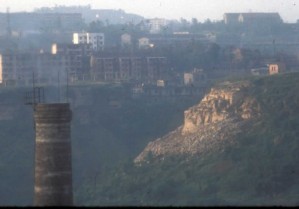 At 6 a.m. the following morning we were blasted awake with the blare of trumpets. This was reveille for the workers and there followed a broadcast over loudspeakers that must have been some sort of pep talk. We decided this was a good time to survey the area, so we roamed around the University and the surrounding streets. First of all it was extremely hot. Chongqing deserves its name as one of the three furnaces of China. The University is on a plateau and thus is a high point. But below the plateau is a plant of some sort and the chimney top for that facility extended to just above the plateau. When the wind blew in the wrong direction we were exposed to the smoke of that monster.
At 6 a.m. the following morning we were blasted awake with the blare of trumpets. This was reveille for the workers and there followed a broadcast over loudspeakers that must have been some sort of pep talk. We decided this was a good time to survey the area, so we roamed around the University and the surrounding streets. First of all it was extremely hot. Chongqing deserves its name as one of the three furnaces of China. The University is on a plateau and thus is a high point. But below the plateau is a plant of some sort and the chimney top for that facility extended to just above the plateau. When the wind blew in the wrong direction we were exposed to the smoke of that monster.
It is readily apparent that the city is very hilly – very few bicycles were seen, at least in comparison with Nanjing. Just outside the gates of Chongda is a market area called Sha Ping Ba. This was our first real exposure to Chinese markets and we were quite taken by the range of foods that were for sale. For example, eels are a delicacy here and many jars of them were being offered for sale. We did our best to ignore them.
The robot for Chongda was set up and put into working condition. It is what is called a manipulator robot. It was basically just an arm that could pick things up, move them, and then put them down. I had some trouble with the computer to drive it, but that worked out. The people were quite taken with the robot, and many of the faculty members wanted to see it in operation. So I had plenty of opportunity to show it off. The decision was made to make a short movie of it, and we got it all set up to go through the operation of moving objects from one place to another. Then the movie crew showed up and set up all their equipment. The lights were turned on and the cameras started to roll. I started the lecture and then activated the robot. The arm just went off by itself not following any of my commands! What an embarrassment. After a few minutes of panic it dawned on me that since the sensors on the joints of the robot were optical it was the bright lights that the camera crew was using that wiped out the optical feedback on the joints. So, we replaced the lights and then things went as expected.
The classes went quite well, since I had been prepared for the process from my experiences in Nanjing during my first trip to China. However a somewhat different environment could be sensed. All the young faculty members sat at the front of the room, and listened attentively while I spoke – they wanted to improve their English. They also wanted to ask questions but this upset the older faculty members – it was a feeling that I wasn’t receiving their respect when they asked questions. So, I asked the young people to hold off their questions until my break time and then they could come in to see me and we could talk things over. It meant no break for me, but the young people were very pleased. I think there was more of an attempt to break away from the traditional way of acting.
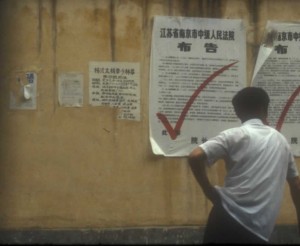 This breaking away was very obvious in one other frightening way. From time to time we would see a large sign posted on a wall, usually with a big red check mark, and we wondered what it meant. The first friend I asked about them just brushed it off and said it was just some local thing. Finally I found out more about what was going on. It seems that some time a person would be accused of some action against the law, and would be tried and if found guilty would be punished. More than once we saw a truckload of men being transported by a police vehicle, and we found they were being taken to be executed. The signs were then placed around the area where the person lived to warn others of what had happened and what could happen to them. The big red check mark indicated the problem was solved – the person was executed. In addition, the family of the criminal had to pay the state for the bullets used in the execution.
This breaking away was very obvious in one other frightening way. From time to time we would see a large sign posted on a wall, usually with a big red check mark, and we wondered what it meant. The first friend I asked about them just brushed it off and said it was just some local thing. Finally I found out more about what was going on. It seems that some time a person would be accused of some action against the law, and would be tried and if found guilty would be punished. More than once we saw a truckload of men being transported by a police vehicle, and we found they were being taken to be executed. The signs were then placed around the area where the person lived to warn others of what had happened and what could happen to them. The big red check mark indicated the problem was solved – the person was executed. In addition, the family of the criminal had to pay the state for the bullets used in the execution.
Sally had several students in her conversational English class, and she reported that their English was excellent – much better than that of her students in Nanjing in 1981. We took a few weekend trips with them and other English speaking visitors including Jack & Elaine Naughton. One trip was to Dazu to view some famous statues there, including the “Sleeping Buddha.” On the way there we drove past rice terraces and vegetable patches as far as we could see. When we got to Dazu we went for a walk through the town and saw many babies with their parents or grandparents. There was also a busy “flea” market. We saw that most families cooked on kerosene stoves and lighted with kerosene lanterns.
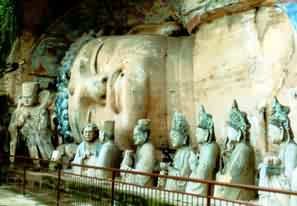 We then bussed to the “Sleeping Buddha.” A small part of it is seen in this picture. It has hands all around it, and by actual count it has 1007 hands. According to Sally’s notes, the sculptures were started in “the first year of Jingfu in the Tang Dynasty” – 892. I was so taken with all these Buddhas that I bought one. It is a very special one in that it is a laughing Buddha, and children are climbing all over the figure.
We then bussed to the “Sleeping Buddha.” A small part of it is seen in this picture. It has hands all around it, and by actual count it has 1007 hands. According to Sally’s notes, the sculptures were started in “the first year of Jingfu in the Tang Dynasty” – 892. I was so taken with all these Buddhas that I bought one. It is a very special one in that it is a laughing Buddha, and children are climbing all over the figure.
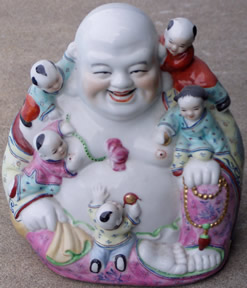 This is a picture of that Buddha – it sits on top of my desk and keeps me pleasant company. There are five little people around the figure. It appears that one of them may be nursing, but I don’t know if there is any gender assigned to Buddha. A search of the internet finds that in some cultures the word byanjana is used to describe a Buddha. This word denotes a sign or mark of gender or other characteristic. Hence, in literal terms the word means ‘a person with the signs of both sexes/genders’. In any event it is so pleasant to have such an icon sitting before me.
This is a picture of that Buddha – it sits on top of my desk and keeps me pleasant company. There are five little people around the figure. It appears that one of them may be nursing, but I don’t know if there is any gender assigned to Buddha. A search of the internet finds that in some cultures the word byanjana is used to describe a Buddha. This word denotes a sign or mark of gender or other characteristic. Hence, in literal terms the word means ‘a person with the signs of both sexes/genders’. In any event it is so pleasant to have such an icon sitting before me.
As we traveled around we noticed that many statues were damaged and this was done by the Red Guard during the Cultural Revolution.
During the night in our hotel room we heard the sound of many firecrackers being exploded. This went on most of the night, and resumed again at dawn. We found that this happened because a person had died that night, and it is a Chinese custom to shoot off firecrackers on such an occasion.
When we weren’t teaching our days were filled with sightseeing. One trip was to the Sichuan Institute of Fine Arts. They had many oil paintings and a fine collection of sculptures. Unlike the exhibit we had seen in 1981 in Nanjing these were a great many pictures of people at work, along with a depiction of a Sichuan minority group. In Nanjing the pictures were mostly of many revolutionary figures and events. In the afternoon we visited another museum that had a remarkable musical instrument on display. It was like a big pan filled with water. When rubbed it hummed like fine crystal. Then we went back to Chongda for supper and then off to Sichuan Opera where the costumes, play and music were great.
Along with the teaching and sightseeing I spent some time talking with visitors about the Rhino Robot. People from all around the area came to see me and see the robot, and I must have ordered about a dozen of them during my stay in Chongqing. I would have money transferred to my account in the states and then pay the Rhino company for the robots. I didn’t make any money at this – it’s too bad I hadn’t set up an agreement with Rhino on these sales!
All this while the rain just poured in Chongqing. All our travels had to be slogging through puddles and mud. Also the temperature was uncomfortably cool along with the rain but fortunately we had packed some long sleeve shirts and sweaters. Altogether it rained every day for our first 12 days in Chongqing.
Everyone claimed that the rains of May are the nicest time in Chongqing. When finally it stopped one day we were delighted. But then that evening we took a short walk to Sha Ping Ba and already the streets were dusty and when a bus goes by it is almost impossible to breathe! Chongqing is either hot and very dusty or cold and rainy.
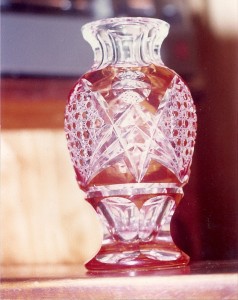 The next weekend we went to the mountain Jin Yen Shan and on the way stopped at the Bei Bei Glass factory. All the work is done by hand and we saw them make tumblers, sherry glasses, etc. and cutting patterns into them. Shown is an example of their work. When we arrived at the hotel we found it was a Chinese Workers Hotel. The beds were hemp pads on a tightly woven mat mattress with a sheet under you, at quilt over you and a pillow made of cement. (At least it felt that way.) The next day we climbed the mountain and viewed the Jailing River in the mist. On the way back to the hotel we encountered a group of men trying to catch a runaway piglet. We had many laughs over that scene!
The next weekend we went to the mountain Jin Yen Shan and on the way stopped at the Bei Bei Glass factory. All the work is done by hand and we saw them make tumblers, sherry glasses, etc. and cutting patterns into them. Shown is an example of their work. When we arrived at the hotel we found it was a Chinese Workers Hotel. The beds were hemp pads on a tightly woven mat mattress with a sheet under you, at quilt over you and a pillow made of cement. (At least it felt that way.) The next day we climbed the mountain and viewed the Jailing River in the mist. On the way back to the hotel we encountered a group of men trying to catch a runaway piglet. We had many laughs over that scene!
Our guide on this trip was a student of Sally’s and his wife. She used to be on the Chinese Diving team. When she could no longer dive she became a factory worker. We drove down the mountain to North Mountain Hot Springs where she had done her diving. There were many children there, aged 9 and 10, and their diving was fantastic.
After lunch we went back to Chongqing and visited the SACO prison. Between 1939 and 1949 the USA and the Kuomintang collaborated against the communists. This prison held members of the Communist Party who were then tortured and murdered here. We could see the torture chambers and dungeon-like cells the prisoners were kept in.
After lunch we went back to Chongqing and visited the SACO prison. Between 1939 and 1949 the USA and the Kuomintang collaborated against the communists. This prison held members of the Communist Party who were then tortured and murdered here. We could see the torture chambers and dungeon-like cells the prisoners were kept in. So, torture is not new in the execution of the foreign policy of our country.
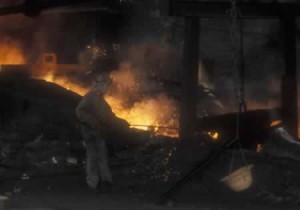 Another time we visited a steel mill, which seemed to me to be terribly old. There were open hearth furnaces and the heat was almost unbearable. However, we were told that a new factory was being built but was not yet open.
Another time we visited a steel mill, which seemed to me to be terribly old. There were open hearth furnaces and the heat was almost unbearable. However, we were told that a new factory was being built but was not yet open.
The signs of change in China seem everywhere. I was told by a representative of the University that the importing of technical equipment can now be done by means other than through the Central Government. Of course I knew that from our experience at NIT in 1981 when we brought over the TRS-80. All the importing of robots that I am involved with is quite new and Chongqing University is one of the new distribution centers.
In early June we were invited to attend the Chongqing School for the Blind. Sally was thrilled by this for she had been agitating for this visit ever since we arrived in Chongqing. The school was started in 1960 and now has a staff of 12 and a total of 25 students. Only one of the teachers was versed in braille, and she is blind. Sally tried to compare the Chinese code with American braille, but was not able to communicate that well. There is a massage clinic connected to the school and some graduates work there. Other graduates become factory workers and cadres.
We saw two classes in operation and the students were following the Braille text books. Later we were given a show by the students and they were fantastic. Their singing and playing the instruments was excellent and they had won first prize in a local contest. I think we were the first foreign students the school ever had.
We then went to the Red Flag Switch Factory where many of the blind people worked. They were all lined up and waiting for us. Again we were the first foreign visitors they ever had. There were 381 employees, 150 were blind or physically handicapped. The government does not collect taxes from this factory and they may keep all their profits for special equipment and welfare for the workers. We met a Doctor of Massage and he and Sally communicated fully about their braille and how it is implemented. Another factory is going to be set up for the deaf and handicapped. The blind and the deaf mutes have great difficulty communicating with each other.
We then visited the home of the blind Doctor of Massage and met his wife. She too is blind and a graduate of the Chongqing School for the Blind. They have a very nice three room apartment plus bath. It was nicely appointed and had many Braille volumes – all on massage. They had a 6 year old daughter, sighted, and she was most pleased to sit on my lap.
We got back to the apartment about 6:40 p.m. It was HOT – 92o The airconditioner was working but could only cool off the sitting room.
Early in the second week in June we took the train to Chengdu. It was an overnight trip, and when we arrived the following morning lo and behold we were met by a person from the Radio Communication Institute. I will give a seminar there the day after tomorrow, so now we will be tourists. The train ride was quite uncomfortable because it was so hot, but we will have time to recover.
We checked in to the Jin Jiang hotel and then spent the day touring Chengdu. We visited the cottage of Du Lu, a famous poet – he wrote best when he was drunk! In the afternoon we visited the Precious Light Monastery which had over 500 Qing statues – all different.
Chengdu is a clean, pretty city. Lots of flowers, trees, and many many bicycles. We saw children standing on a rear package carrier and strapped to a parent. I still wonder how the bike got started up. It must have been tricky.
The next day we visited a massive flood control project. It extended over many square miles. In the middle of it was a temple, but this one had no Buddhas. Instead there were two statues – of the architect who designed the flood control project and his son. Yet there was evidence of prayers being said there – Kowtow pillows and burning incense.
The next day I gave the seminar on computers and robots. Then lunch and it was fantastic. There were beautiful blossoms arranged on a lazy susan and dishes of “roses” made from slices of pickled potatoes. That night we took the train back to Chongqing. We were in a compartment of four passengers arrayed in two double bunks. The heat was suffocating again.
Back at Chongda we packed for our departure the day after tomorrow and met the couple that was going to take over our apartment.
The next day Sally & I went with Prof. Zu from the Chongqing Post and Telecommunications Institute to his school on the South side of Chongqing. They gave us a tour first, and we went to Huang Shan, (Yellow Hill) to view the former home of Chiang Kai Shek and the homes of the Song Sisters (one married to Chiang Kai Shek and the other to Dr. Sun Yat Sen). The home is now a sanatorium and it is occupied by peasant people. There is a nearby tunnel in the mountain where Chiang used to go. This tunnel had 3 openings to it and the Chinese say every rabbit den has 3 holes, so he must be a rabbit.
After a short rest I gave a seminar to the students and faculty. This school is so far up in the mountains that they seldom receive any foreigners. When I was finished Sally gave her talk on the School for the Blind and a factory staffed by blind workers. We then went back to Chongda for a farewell banquet. We had the usual festive meal and wines and they gave me a lovely Chinese painting of Mount Tai. We gave them some gifts too, including a Disarmament Now poster. After all this we said goodbye to the Naughtons as we were leaving the next morning for the trip down the Yangtze.
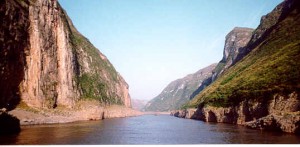 The trip started at about 5:00 a.m. and was absolutely beautiful. Once again our cabin was hot, but the scenery was fabulous. We saw an old road along the cliff that was carved out some 1700 years ago. At one point we saw a mule pulling a boat upstream.
The trip started at about 5:00 a.m. and was absolutely beautiful. Once again our cabin was hot, but the scenery was fabulous. We saw an old road along the cliff that was carved out some 1700 years ago. At one point we saw a mule pulling a boat upstream.
 We traveled through the Three Gorges for three nights and finally came upon the Gezhouba dam and lock. This lock drops us some 20 meters in one lock – certainly the largest lock I have ever seen. They often have trouble with the gates in the lock because of the buildup of dirt being washed downstream. This picture gives some idea of the size of the lock. We arrived in Wuhan in mid afternoon the following day and were met by a representative from the Mid-China University of Technology. They had failed to purchase airline tickets to fly us to Nanjing the following day, so we had to spend an extra night in Wuhan. The apartment we stayed in was nice, but all air conditioning is turned off at 11:00 p.m and we just sweltered. I had been pressured to give a seminar here but I refused to do so. Well, that was probably a mistake because they had even more trouble getting the tickets to Nanjing and another night was added to our stay.
We traveled through the Three Gorges for three nights and finally came upon the Gezhouba dam and lock. This lock drops us some 20 meters in one lock – certainly the largest lock I have ever seen. They often have trouble with the gates in the lock because of the buildup of dirt being washed downstream. This picture gives some idea of the size of the lock. We arrived in Wuhan in mid afternoon the following day and were met by a representative from the Mid-China University of Technology. They had failed to purchase airline tickets to fly us to Nanjing the following day, so we had to spend an extra night in Wuhan. The apartment we stayed in was nice, but all air conditioning is turned off at 11:00 p.m and we just sweltered. I had been pressured to give a seminar here but I refused to do so. Well, that was probably a mistake because they had even more trouble getting the tickets to Nanjing and another night was added to our stay.
As we walked around the town we noticed that cyclists were forced to get off their bikes and walk them down a particular hill. A policeman was stationed there and made sure they got off their bikes. I never could figure out why that was so.
We thought we would never get out of Wuhan, and that almost became true. Our guide in Wuhan finally told us we had tickets for an evening flight, and he accompanied us to the airport and then left after we got out of the car. We waited for a few hours and then realized our plane was delayed. A woman made an announcement on the P.A. system, but it was in Chinese and we started to get scared. I saw a Chinese man that I felt was from Hong Kong and he explained that we would be leaving soon on a different plane. We finally boarded that plane, which again was HOT, but the CAAC gave each passenger a hand fan. Big deal! They tried the engines a couple of times and then the cockpit crew left the plane. Then they advised us to leave the plane, but leave our luggage on board.
The same sequence was then repeated on another airplane. Board it. Sweat in the heat. Get off the plane. We sat in the airport for another hour or so, and then were advised to take our luggage from the pile that had been unloaded. A short time later they loaded our luggage on still another plane and we boarded it. We got onto an ancient vehicle that looked like a boxcar. It revved up its engines and slowly taxied down the runway. It barely achieved flying speed by the time the end of the runway was reached and we were off to Nanjing.
The people from the Nanjing Institute of Technology (NIT) met us and took us to a new wing of the same hotel we had stayed in1981. The set up of my classes were all in good shape, and it was great to see so many people we knew. This included the Vice President Wang, also the wife of Jai who was back in Syracuse, and my visiting scholar, Chen, Huang Chun. We also met a female faculty member who expects to go to Syracuse University into the Civil Engineering Department. She is the same person we had dubbed (Miss Want to Buy?). We also lunched in the Jin Ling Hotel. This is the tallest building in Nanjing – 37 stories. On the top the Sky Palace restaurant revolves around and it was something to see the trees from above!
Chen, Huang Chun asked me to give a lecture at his plant, and I agreed to do so. He said there is very little output from the factory at his institution. Visitors are told that 500 people work there but it is actually 5000. He said that people work maybe one week out of a month and the rest of the time just “play.” He also said that production is down in large industries, but that in light industry, e.g. watches, TV, clocks, etc. it is much higher.
After this visit Sally and I visited Chen in his apartment. It was of decent size – a kitchen, living room and two bedrooms. We entered into a small room which held a small table, some stools, a bicycle, and a good sized refrigerator with a black and white TV on top. Every square inch of space was used for some gadget Chen had bought, including an ice cream maker. Off this room there was a bathroom, a new washing machine squeezed in, and a western toilet. They served us maybe six different kinds of sweet cakes plus coke, beer and tea. We then looked over a few photo albums, and all in all we had a fine evening.
Chen’s company had a banquet for us. It was held in an old house formerly owned by the British Consulate – in the 40’s. Again the food and the presentation was excellent. The center piece of food looked like a painted butterfly done in tempura style. It was formed from seaweed, eggs, carrots and other edibles.
I had brought an intestinal bug with me from Chongqing and finally went to a hospital here in Nanjing. They gave me some medicine that seemed to work. However the sanitary conditions in the hospital were horrible. Everyone‘s uniform seemed soiled and unwashed and also the bed linens. I am glad I had no need to stay there overnight.
The temperature in Nanjing is really rising, and so the air conditioning is shutting down. The temperature reaches 102 degrees each day – if it reaches 104 then they close the factories.
Ming Hu has arrived, and they rolled out the red carpet for him. We had another sumptuous banquet, and saw old friends again. We sure have a lot of banquets in China.
One afternoon Sally and I and Ming Hu were invited to visit Prof Chen, who is Ming’s father-in-law. He is a much respected 85 year old former president of NIT, and was Ming’s teacher back in the ‘40’s. In 1926 he was in Schenectady working with some of the great people in early radio. He and his family live in a private home not far from our hotel. His home was a different world. This was his home before the revolution and he was permitted to keep it. It has a walled in area with a garden and the house has several rooms and two floors – and a servant. We were served a special dim-sum, and had marvelous conversation. Prof. Chen’s English is excellent. Despite the fact that he lives in almost elegance in Communist China, he feels the new system is good. He felt the education system was good because the ideas about educating women are changing. More girls are entering the lower grades so the percentage in College will increase in time. (In the past it was deemed useless to educate women.
In mid July we took a side trip to Wuxi, about a 3 hour train ride from Nanjing. We were met by a guide from CITS and spent two days visiting gardens, eating, and taking a boat ride on Lake Tai. This is a huge, but shallow, lake. It extends beyond the horizon, so I guess it must be at least 15 miles long in that direction. We stopped at a co-coonery and saw trays of silk worms feeding on mulberry leaves. When they are adult they turn transparent and are transferred to “straw dragons” to spin their cocoons.
Later in the afternoon we rode back to Nanjing, and found a note from Elaine and Jack Naughton. We will be seeing them before we leave Nanjing. Later we went to an acrobatic/juggling/mimicry show. We didn’t need to know Chinese to appreciate it. It was a most joyful evening. The next night we had dinner with the Naughtons, and shared many of our experiences. It seems they got the same treatment in Wuhan that we received!
One thing we have noticed is that there are many more tourists in our hotel than there was in 1981. Many farmers are able to come in since the inclusion of the free markets and their ability to keep part of their produce.
In the latter part of July we took our leave from Nanjing and traveled by overnight train to Beijing. After we arrived there we checked in to the Friendship Hotel. That evening we went to an excellent mime performance. Among the scenes depicted was one on criticism of the bureaucracy – (a man trying to get his travel papers signed), a good political message and also a social message on how hard the worker was trying to clean the streets while another person continually littered! A scene about a new TV set was hilarious!
I had a couple days of lectures at the BIAA, and they went well. They had some trouble with some software on their Apple II, and we got that working. Sally had a good interview with the Vice Chairman of the China Association for the Blind and Deaf. They discussed the various forms of braille, and the status of braille development in China. One evening we had real Peking Duck at the most famous and oldest Peking Duck restaurant in Beijing. It was a fantastic meal.
One morning we went in search of the Catholic Cathedral of Maria in Beijing. It was built in 1606 with the efforts of Matteo Ricci. We attended mass since it was a Sunday and noticed that many non-Chinese were in attendance. We found out later they worked for various embassies. The mass was in Latin, and non-participatory. In the afternoon we met with a couple of Americans who are in China to open up a “Computer Land” in China. We also met Sam Chen who teaches biology at Syracuse University and lives at the far end of our street. He was born in China, grew up in Hong Kong and is now an American citizen. He said he came expecting the worst but has been delighted with what he has found.
A couple of days later we went back to the Cathedral of Maria. We were taken to the Haidin District to see the three tombs of the Jesuits: Matteo Ricci, Schall Von Bell and Vierbiest. Then we went to the Great Hall of the People. It has a 10,000 seat auditorium and a banquet room for 5,000. That night we went to a magic and illusion show, which we enjoyed very much.
The next morning we left for the airport and flew to Guilin and stayed at the Rong Hu hotel. Also saw two more criminal signs on the way. Our sightseeing included a trip to The Silk Brocade Hill. There were many caves and walks – none serious. We also saw a Pinjing garden and the trees were fantastic. One time there was a sea here and the area is ringed with limestone outcroppings. Tourism is the main business and the city is 2000 years old.
The next day we took the boat down the Liang River to Yangchow. The sights were simply glorious. The hills around Guilin are fantastic, and we enjoyed this for about 6 hours. Along the way we saw fishermen with their cormorants. The birds have rings around their necks, are sent into the water to catch fish, and then, unable to swallow them because of the rings, bring them back to the fisherman. Many fishermen have small bamboo rafts with baskets on them.
This is a heavy tourist area. We did a little shopping and people paid for their goods with US dollars and Japanese yen. Again we see many of the ‘criminal’ signs. A man was making Chinese writing using double brushes. We had him make one for us, and it says “a happy couple.” Again there were loads of tourists, and taxis cruise the streets. One man stopped me on the street and wanted to change money.
We then took a train to Shenzhen. Here prices are quoted in HK dollars. We stayed in a resort hotel, and like all of Shenzhen it is still under construction. We had a bit of a problem with our hotel bill. We wanted to pay for it in RMB we had earned in China and the people here didn’t know how to handle this situation. Here the people speak Cantonese – not Mandarin. Our guide can’t understand them. He has to watch TV from Hong Kong which is in English in order to get the news. Many people from Hong Kong are here – they travel here for the day. We visited computer stores and a company involved in software. It is obvious that this city is headed for something big. They have a huge reservoir here that supplies water to Hong Kong. Hong Kong supplies Shenzhen with electricity.
The next day we left for Hong Kong. We had to change Chinese funny money first to US dollars then to Hong Kong dollars. We had been using the services of one guide, Shao Shu, all the way from Nanjing, and it was sad to say goodbye to him. One grows very fond of your interpreter who guides you through all the language and ticket problems and is so very vital to you. He could not go the last 30 meters with us. Goodbye seems so final.
After leaving China we took a “bee liner” type train – ½ hour to Kowloon. We stayed at the YMCA in Kowloon, and that night had supper with Jack and Elaine.
The next day we flew to Manila and were met by Dennis Bermejo and Rudy Vale – also Francine’s aunt Mila, Aunt Cora and cousin Vera. The robot I had ordered for USC had arrived, and Dennis reimbursed me in Pesos for it. We stayed at the Aloha hotel and while they served Sichuan food we said “Enough is enough!” We ate Filipino. For dessert I asked if they had watermelon and they replied: “Sorry, only mango and papaya!” What a joy to be back home!
In early August we flew to Cebu City. We had rooms at San Carlos Girl’s High, and proceeded to see a lot of our friends. The President of USC, Father Commaco, had a car for us – a very large Mercedes with a Toyota engine. One day we were parked at Ruston’s on Mango Avenue, and I slowly left the parking lot to enter traffic. The accelerator fell off as we were perpendicular to the traffic. With a lot of help, and Sally steering, we got the car to the curb and an hour later a mechanic showed up to fix the problem. He gave us a ride to Talamban, where I gave the first of many lectures about the robot.
We attended various parties over the next few days. Sally met Rey Crystal from NEDA, and they had a lot of business to discuss about the Braille Center. On Sunday night we had dinner with the priests at San Carlos, after having a few drinks in their rooftop bar. Sally checked out the Braille Center and found there were now 16 students being mainstreamed and 6 more in preparation. Everyone is talking about their husbands going to Saudi Arabia to make money. Nellie’s husband Rene is thinking about going to the US to be a migrant worker in California.
When Sally first went to the Braille Center she was greeted with cheers. They had been looking for her and were delighted that she finally arrived. Rey Crystal invited everyone one to the Country Club to celebrate Sally’s birthday – she is now 58! That evening we had dinner with the family of Dina Ng Mueller – a big Chinese family.
The next day we took care of the tuition for Nellie’s daughter Marilou. We made arrangements for her to pick up the money from Dennis Bermejo’s business – we are helping her to attend the University of San Carlos. We hired a PU to go and look at our first residence at Andres Abellana, and then to Guadalupe Heights. One night we went to the Jai Alai, and I won 275 pesos!
Finally, on August 11 we finished our packing and flew to Manila. Once again we stayed at the Aloha Hotel. We almost missed our flight back since I hadn’t check departure times, which had been changed. But, we made it, and due to crossing the International Date line, we arrived in Syracuse on the same date we left Manila.
What a fantastic few months we had, again. Meeting old friends in China and the Philippines and making new ones is such a joyful way to be able to live. We must return to the Philippines again!
The First End
Now that China is over, it becomes time for me to consider what I will be doing next. I have stopped peddling my mobiles, and I am busy at Syracuse University. After returning from China I became Academic Chairman of our off-campus center in Poughkeepsie and this requires that I spend one night each week at Poughkeepsie. This appointment lasted for two years. I became highly involved with getting the 64000 Baud leased line functioning between the SU Main campus and the center at Poughkeepsie. It was located and Marist College. Also I remained active with the AAUP and in fact began calculating and publishing the annual Faculty Salary report using digital data supplied by the Administration.
About this time, 1985-6, President Marcos of the Philippines was heading for big trouble. He called what he dubbed a “snap election” in an effort to cement his hold in the Philippines. Much to his chagrin the people voted him out of office! His major opposition in the past came from Ninoy Aquino, and Marcos had made the big mistake to have Ninoy assassinated. His wife, Cory Aquino, picked up the battle and ran a campaign against Marcos. The cry of People Power was heard around the land, Cory was elected and in 1986 Marcos fled the country. He filled a plane with pesos and headed for Hawaii for his retirement. So, it seemed to me that it was time to go back to the Philippines.
I talked it over with Sally, and she too thought it was a good idea, and I proposed to San Carlos that we would bring ourselves back and teach there for a semester if they would supply us with living quarters near the Talamban campus. I would teach in the Engineering college as my part of the bargain. Dennis Bermejo, who was the chair of the Electrical and Communications Engineering (ECE) Department, had started a program in Computer Engineering and wanted to improve it. We decided that I could help instruct the faculty so that they could teach the necessary courses. At Syracuse University I talked this over with the Department Chair – Norman Balabanian – and told him I would like to teach in the summer and fall semesters in Syracuse and take off the winter semester. This sounded good to him because we were developing a sizable number of courses to be taught in the summer, and this would fit right in with those plans. Sally was very willing to go back so that she could help to keep things going at the Cebu Braille Center which she was instrumental in getting established during our stay in 1978-79. So everything just fell into place.
When the people at USC found out I was coming over they put together a “wish list” of the kinds of things they wanted. EPROM burners, computer hardware, and, one year the electronics and mechanical hardware for a satellite dish! I bought this for them, brought it over, and they reimbursed me. I never had trouble getting this material through customs in Manila, as I had a letter from the President of the University that indicated these were gifts for this private, non-profit, organization. We went there in January every year from 1987 through 1997 so the people in the customs area in the Philippines got to know us, and welcomed me each year with “Mabuhay, Father.” We stayed for three months, January through March and thus avoided winter in Syracuse. A couple of times we let friends stay in our Standish Drive house while we were gone but mostly we just left the house empty.
At first the University of San Carlos had a little trouble finding a place for us to stay. The first place we stayed was in a compound operated by Helen and Henry Uytengsu and that was very convenient since it was about a 10 minute walk to the campus. There were several different rooms she had for rent and each year we would try a different one. One proved to be very damp, another was notable because the decoration in the room was extra large pictures of playing cards and a third was nothing remarkable – just nice. There was a second floor and once we stayed up there. We got to know the Uytengsus fairly well. One time Henry pulled me aside because he wanted to talk about religion since he felt he was in deep trouble. He had a wife Helen here in Cebu and another wife in Canada. He wanted assurance from me that he would not go to hell for this transgression. I gave him my usual blessing. Across the road from Helen’s place was the home of Bing and Deter Suenholz. He is of German citizenship and spends part of each year in Germany running his Export/Import business. Sally and I would play mahjong with them and Helen from time to time.
After a few years of this moving around the University refurbished a dormitory that had been built with funds from a governmental group called CocoFed. This building had two floors and they took one half of the ground floor and made it into an apartment for Sally and me. This was great for us as it was in the Talamban campus and thus close to where I spent most of my time. It was a short jeepney or taxi ride into Cebu City so that too was convenient. The University even offered to supply us with dinner each night. There was a retreat house well up the hill from Cocofed and each night a courier would walk down from the retreat house with a meal for us. It was fairly good food, but often we would go to a nearby restaurant instead.
The department chairs of the ECE Department changed a bit while I was there and here is a listing that was compiled with some effort:
Benedicto Supremo – 1967 and 1968 at least. – During my first Sabbatical
Hilarion Lim – ?
Arturo Espinosa (until 1976 when he left to join William Lines, Inc.)
Dennis Bermejo – 1976 till 1986 – During my second Sabbatical
Victor Abarquez as OIC from 1986 to 1987
Roger Bajarias 1987 till April 1991
Roger Yap May 1991 till May 1994
Mario De La Victoria – June 1994 – May 1995 Chair of EE/ECE/ComE
EE/ECE/ComE split into two:EE/ECE and ComE
EE/ECE Department ComE Department
June 1995 – May 30 1997 – Rafael D. Seva Jr. Joseph Karl G. Salva – First Chairman
June 1997 – September 2000 – Alberto S. Banacia JoMari Maja
October 2000 – May 2003 – Joseph Karl G. Salva
June 2004 – May 2005 _ Ellen Agnes M. Zafra (former Ms. Mansueto)
June 2005 – May 2006 – Rodulfo Vale
June 2006 – May 2008 – Alberto S. Banacia
June 2008 – Thammar Tan
June 2009 – Baltazar Raffinan
Chairman for Computer Engineering – Joseph Karl G. Salva
then followed by Dr. Joe Mari Maja
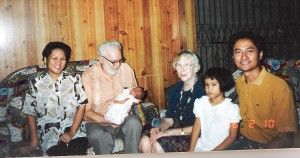 When I showed up in January, 1987, Roger Bajarias was the Chairman. I got to know him and his family quite well. We worked together in developing the faculty and setting up courses for me to teach. After being Chairman for about four years he accepted a job with KGS Corporation and this required him to move to Japan. The company manufactured Braille reading equipment and he worked for a few years in Japan. While there their second child, another girl, was born. Unfortunately she was quite premature and required oxygen in order to save her life. This resulted in her losing her eyesight so by the time she left the hospital she was blind. This is such a combination of circumstances I am dumbfounded by it. Roger working for a company making aids for the blind, then having a blind child, and Sally’s involvement with Braille and the Cebu Braille Center, and finally the child going to the CBC and being involved with Nellie Bautista who was Sally’s motivation for getting into Braille production. What a world we live in!
When I showed up in January, 1987, Roger Bajarias was the Chairman. I got to know him and his family quite well. We worked together in developing the faculty and setting up courses for me to teach. After being Chairman for about four years he accepted a job with KGS Corporation and this required him to move to Japan. The company manufactured Braille reading equipment and he worked for a few years in Japan. While there their second child, another girl, was born. Unfortunately she was quite premature and required oxygen in order to save her life. This resulted in her losing her eyesight so by the time she left the hospital she was blind. This is such a combination of circumstances I am dumbfounded by it. Roger working for a company making aids for the blind, then having a blind child, and Sally’s involvement with Braille and the Cebu Braille Center, and finally the child going to the CBC and being involved with Nellie Bautista who was Sally’s motivation for getting into Braille production. What a world we live in!
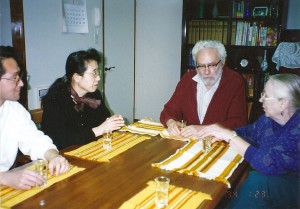 So, Roger works for KGS and he is the manager of their plant in Mactan. Anytime I am in the Philippines I contact him. One time this contact went a lot further because of involvement with a product of KGS. Roger set up a trip to KGS in Tokyo for Sally and me to spend a few days there evaluating a new Braille writer they were planning to market. What we did was to fly to Tokyo from Cebu and then meet with their personnel to try a new braillewriter and give our comments. This was great as we stayed in the house of President Takeo Kurematsu and got to see the functioning of a Japanese family. The picture is of President and Ms. Takeo and Sally and me. They had one daughter and one day as he was driving us to a meeting at KGS Corporation he told us that on that day his daughter was scheduled to take an examination for admission to college. This is a very important exam because it is difficult to get into College in Japan.
So, Roger works for KGS and he is the manager of their plant in Mactan. Anytime I am in the Philippines I contact him. One time this contact went a lot further because of involvement with a product of KGS. Roger set up a trip to KGS in Tokyo for Sally and me to spend a few days there evaluating a new Braille writer they were planning to market. What we did was to fly to Tokyo from Cebu and then meet with their personnel to try a new braillewriter and give our comments. This was great as we stayed in the house of President Takeo Kurematsu and got to see the functioning of a Japanese family. The picture is of President and Ms. Takeo and Sally and me. They had one daughter and one day as he was driving us to a meeting at KGS Corporation he told us that on that day his daughter was scheduled to take an examination for admission to college. This is a very important exam because it is difficult to get into College in Japan.
 As we were driving he looked up and was startled that Mount Fiji was visible! He explained to us that this was a remarkable sign of good luck and he was thrilled that the mountain became visible that day. It is a nearly perfectly shaped volcano that last erupted in 1708. Here is a picture of Mount Fuji that I found on the web. I never did find out how his daughter did on the exam. While we were in Tokyo we were treated grandly except one evening he took us to dinner at a Korean restaurant. This meant sitting on pillows and eating off a low table. Sally and I had indicated that we would enjoy a western meal since it had been some months since our last one. So we were surprised when we ended up at the Korean restaurant. Another little anomaly was that Kurematsu asked us to pick up some ubi ice cream in Cebu and bring it to him. He really loved this ice cream and he couldn’t get it in Tokyo. We were only too glad to do this and we hand carried the treat to him. Of course he was very polite in thanking us but he never offered to pay for it. So we never got the opportunity to tell him we were giving it to him as a gift.
As we were driving he looked up and was startled that Mount Fiji was visible! He explained to us that this was a remarkable sign of good luck and he was thrilled that the mountain became visible that day. It is a nearly perfectly shaped volcano that last erupted in 1708. Here is a picture of Mount Fuji that I found on the web. I never did find out how his daughter did on the exam. While we were in Tokyo we were treated grandly except one evening he took us to dinner at a Korean restaurant. This meant sitting on pillows and eating off a low table. Sally and I had indicated that we would enjoy a western meal since it had been some months since our last one. So we were surprised when we ended up at the Korean restaurant. Another little anomaly was that Kurematsu asked us to pick up some ubi ice cream in Cebu and bring it to him. He really loved this ice cream and he couldn’t get it in Tokyo. We were only too glad to do this and we hand carried the treat to him. Of course he was very polite in thanking us but he never offered to pay for it. So we never got the opportunity to tell him we were giving it to him as a gift.
The meetings on the Braille writer went OK, but we had much too much time to talk about it. The meetings were with the heads of various departments and the President of the company but we were rather critical of the unit. It had nothing original about it and was hardly up to date even for the early 90’s – no modem was included so there was no access to the Internet. But, we finished it all up and headed back to San Carlos after a few days.
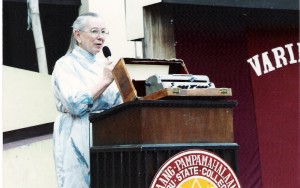 During these trips Sally spent a lot of time with Nellie and the people of the Cebu Braille Center. At one point the Cebu State College, the place where the Braille Center was located, decided to honor her. They had a nice convocation and gave Sally a plaque in recognition of her contributions. This picture shows her giving an acceptance speech for the honor. On the podium in front of her is a Perkins Braille writer which is what she and the transcribers used at the Braille Center.
During these trips Sally spent a lot of time with Nellie and the people of the Cebu Braille Center. At one point the Cebu State College, the place where the Braille Center was located, decided to honor her. They had a nice convocation and gave Sally a plaque in recognition of her contributions. This picture shows her giving an acceptance speech for the honor. On the podium in front of her is a Perkins Braille writer which is what she and the transcribers used at the Braille Center.
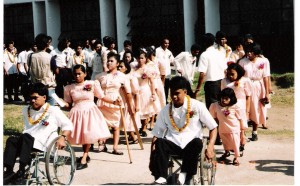 She also spent time with Nellie at the AVRC (Area Vocational Rehabilitation Center) and we attended the graduation ceremonies there. is a picture of one of the graduation ceremonies. All of the graduates are challenged in one fashion or another and they all were quite thrilled to be finishing up with their formal education. Moreover some of the blind students will go to the Cebu Braille center for more access to higher education.
She also spent time with Nellie at the AVRC (Area Vocational Rehabilitation Center) and we attended the graduation ceremonies there. is a picture of one of the graduation ceremonies. All of the graduates are challenged in one fashion or another and they all were quite thrilled to be finishing up with their formal education. Moreover some of the blind students will go to the Cebu Braille center for more access to higher education.
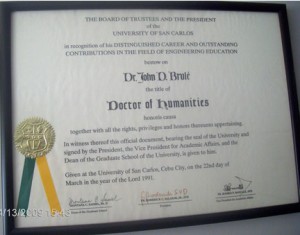 Roger Bajarias was Chairman of the Department and he helped to set up a program with local industry for the purpose of increasing the cooperation between local industry and the University. So several visits were made to possible partners and I helped in these visits and in setting up some of the courses. This all worked out just fine and the University was so happy about it that they awarded me an honorary doctorate. The citation read “…in recognition of his Distinguished Career and outstanding contributions in the field of Engineering Education.” March 22, 1991. I thought that was pretty nice. This happy event preceded a reduction in my health a few months later. In the first week of August I underwent a heart bypass operation. I had been having some chest pains and when I went to the infirmary at Syracuse University for my annual checkup the doctor threw the book at me and made an appointment for a stress test the following week. So, I never had a heart attack but did have the operation. I went back to the Philippines in January of 1992 and things seemed OK. However I got too involved with running around and developed chest pains again. So upon my return to Syracuse that was checked out and the conclusion reached that all I needed was to be more sensible. In fact, things were so good that in the Spring Sally and I returned to Hawaii and did a lot of sightseeing, including a mule ride down to the leper colony on Malakai. However this threw a scare into me and I decided to take advantage of the offer by the University to accept early retirement. So I officially retired in 1997 although for the next couple of summers I taught a summer course at SU. Incidentally the occasion of my retirement party brought a visit to the gathering from Dolores. I had gone to her retirement party in 1990 – we just had two or three meetings over the years from when I left for the Philippines in 1967. Sally and I started having celebrations of our wedding anniversary every five years beginning in 1982 for our 35th. We would celebrate it in the summer and had a catered outdoor gathering. Usually we had my favorite group, Cranberry Lake, play at the event. This meant that it would end up with the group square dancing and having a ball!
Roger Bajarias was Chairman of the Department and he helped to set up a program with local industry for the purpose of increasing the cooperation between local industry and the University. So several visits were made to possible partners and I helped in these visits and in setting up some of the courses. This all worked out just fine and the University was so happy about it that they awarded me an honorary doctorate. The citation read “…in recognition of his Distinguished Career and outstanding contributions in the field of Engineering Education.” March 22, 1991. I thought that was pretty nice. This happy event preceded a reduction in my health a few months later. In the first week of August I underwent a heart bypass operation. I had been having some chest pains and when I went to the infirmary at Syracuse University for my annual checkup the doctor threw the book at me and made an appointment for a stress test the following week. So, I never had a heart attack but did have the operation. I went back to the Philippines in January of 1992 and things seemed OK. However I got too involved with running around and developed chest pains again. So upon my return to Syracuse that was checked out and the conclusion reached that all I needed was to be more sensible. In fact, things were so good that in the Spring Sally and I returned to Hawaii and did a lot of sightseeing, including a mule ride down to the leper colony on Malakai. However this threw a scare into me and I decided to take advantage of the offer by the University to accept early retirement. So I officially retired in 1997 although for the next couple of summers I taught a summer course at SU. Incidentally the occasion of my retirement party brought a visit to the gathering from Dolores. I had gone to her retirement party in 1990 – we just had two or three meetings over the years from when I left for the Philippines in 1967. Sally and I started having celebrations of our wedding anniversary every five years beginning in 1982 for our 35th. We would celebrate it in the summer and had a catered outdoor gathering. Usually we had my favorite group, Cranberry Lake, play at the event. This meant that it would end up with the group square dancing and having a ball!
In this time interval the use of the Internet was expanding and it seemed to me that the Philippines was perhaps out of the loop. My good friend, Rudy Villarica, was deeply involved in setting up the administrative infrastructure that could push the internet forward in the Philippines. I was interested in the use of email and looked in to that. It seems that the only access that was available was for the users in the Philippines to transfer their letters to a station in Australia and then the people there had an internet port and they would forward our mail on to the desired recipients. A highly cumbersome and almost useless way of communication. But I knew that better times were coming because Rudi indicated they were negotiating for a dedicated line between the Philippines and the USA and were working out the financial aspects. So I decided that it would be great to have an email conference in Cebu and asked the administration including the President of the University if they would support it. Indeed they would so I really started to dig in. It was then that I made contact with other interested parties in Scandinavia and in Hungary and we worked out the details over the internet. So on March 22, 1994 the link came into existence and we had the first on line contact between the USA and the Republic of the Philippines. In the USA there was Mark Brule at his machine and me in the Philippines on mine. So we greeted each other via Telnet and the connection was completed.
As stated in a local publication:
In the ensuing years I worked with the Dean and the Chair of the department to help out in the development of the Linkage Program. This was part of an effort to get more involved with local industry. For the following three years – 1995 through 1997 my three months each year was spent in teaching graduate courses to the students in the program and visiting local industry. And of course I continued with my summer and Fall semester teaching in Syracuse.
Unknowing what was about to happen, I wrote the following note for our Christmas greeting in 1997
December 22, 1997
Dear friends,
What a good year we’ve had!
Our trip to the Philippines was our 15th visit in 30 years and our 11th in the
last 10 years. It was good to see our old friends again.
We stopped in Hawaii on the way back and visited John’s sister and her family. Then it was great to get back home with our children and grandchildren later in April. In early July we met friends from the Philippines. We drove to 1000 Islands to see them, and had fun showing them a little of the USA. Later in that month Sally’s sister and her husband visited us here in Syracuse.
In August we had a marvelous party celebrating our 50th wedding anniversary. Friends and family from Michigan, Ohio, Virginia and Maryland all visited. We received greetings from the Philippines, Canada and New Zealand. The day was perfect and we all had a super time.
In September we drove to an Elderhostel at Natchez Trace State Park in Tennessee, and got to know the kudzu somewhat better and in the process discovered what a pretty state Tennessee is. On the way home we stopped in Nasbville to check out the Grand Ole Opry, and then spent a few days in Kentucky with Sally’s sister.
Gina Nicole was born to Nannette on October 15, and became our 5th grandchild. If you’d like to see her picture, check our web she at:
Now Christmas is fast upon us and we are busy getting ready for the festivities. We hope you all have had a good year, and that the holiday season will be a happy one.
With warmest wishes,
John and Sally Brule
Then the world started to change after Sally and I celebrated our 50th wedding anniversary in the summer of 1997.
The First End
“Shy, what has happened to you?” I was in the kitchen looking for a bite to eat while Sally dialed a telephone number. I turned around just in time to see her slump to the floor. Fortunately I caught her before she fell, but she seemed to be unconscious. I held her and in a moment she came out of it. “My darling, what is it?” “What happened?” She replied, “Why are we sitting on the floor?” Obviously something was really amiss and we had shrugged off a similar episode a week or so before feeling maybe she had just overworked, or something. This was the wakeup call to look into things. A contact with Dr. Croglio led to him setting up an appointment for Sally to have an encephalogram at the earliest possible time. This was set for mid December, 1997.
On the appointed day we went to the site for the x-ray, and while we were waiting we saw Marian and Alex Stanislaw leave the laboratory. We chatted for a few moments, but didn’t do any questioning about why we all were there. The encephalogram of course gave no clues as to what was going on, for one reason because this was the first one she had made and there was nothing to compare it to. On a follow-up visit with Dr. Croglio he said that they had no idea what was wrong with her, and suggested we could try sending her to the hospital for observation. Sally and I both agreed that we could do the observing at home and it would be much more relaxing and beneficial than being in the hospital.
The end of the year was coming, and we had some decisions to make. “Shy, I think we had better cancel any thoughts of a trip to the Philippines this year; what do you think?” It didn’t take Sally long to decide that that was a good idea. “Let’s wait until I feel better, then we can decide what to do,” she said. So we had a quiet New Year’s eve, and just stayed around the house. Then on Friday January 2nd we decided to do a little shopping for some food, and browsed around Peter’s for some more materials. That evening Sally made up a stir fry and we had our dinner while watching Wheel of Fortune and a couple other programs. About 10:30 we both decided to call it a day and went upstairs to get ready for bed. She went to bed first and I was in the bathroom brushing my teeth when I heard a strange sound from our bedroom. I went to see what it was, and Sally was lying stretched out and motionless in the bed. “Shy, are you OK?” I cried, but soon realized that while she was still breathing there was no vital life left within her. I held her in my arms for a moment and then I called 911. The EMTs arrived quickly and asked me to leave the room. They moved her from the bed to the floor to make it more convenient to work on her, I presume. I went to my study across the hall and heard them trying to get her to respond.
I called Nannette and Mark and told them what was going on, and that we were heading for the hospital. I called Jim but he wasn’t home – he was overnight in Watertown for some work associated with the temple. Jill answered the call, and came to the house as quickly as she could. By the time she arrived the EMTs had left and she wanted to know if she could help out? I asked her to clean up the floor area where Sally’s body had been and then we all left for the hospital.
By the time we got there Sally had been filled with tubes and instruments and was on a lot of monitoring equipment. Shortly thereafter Jim arrived from Watertown and we all went to look at Sally and to get a feeling about what was happening. I looked at that almost lifeless body – the mother of our children and my heart and soul for the past 50+ years. I talked it over with the nurse in attendance, and came to the realization that her life was over. I called to our children to come and see her one more time, and then told the nurse to let her die.
She never regained consciousness and her life ended peacefully early Saturday morning, January 3, 1998.
These events are etched in my mind, and return to my awareness to bring back so many wonderful memories. Sally’s body gave out, but she left us her spirit. That will never be taken from me.
Her body was transported by Burns and Garfield. I decided we would have a viewing, but it would be with a closed casket. However before that started I wanted all my grandchildren to view their grandmother’s remains in the open casket. So this was done and then there was mass in the rooms of the mortuary. Everyone that wanted to could receive bread during the communion –either consecrated bread or specially prepared bread. People had the opportunity to speak about Sally after it was all over.
We then were informed that the ground was not yet frozen and thus her remains could be buried in our plot in the Throopsville Cemetary. So I decided that her remains be cremated and members of the close family attended the burial of the ashes on the following day. May she, and all of us, rest in peace.
?We had received indications during her last few years that all was not well. In 1987 after our return from the Philippines in what was to be an annual event for the next decade she suffered a ‘minor’ heart attack. In fact she was in her doctor’s office at the time she felt chest pains and she was rushed immediately to the emergency room. After a couple of days there she was released. Fortunately, during that time she stopped smoking – they don’t like people to smoke in the intensive care unit. She never smoked again.
Sometime after this event she started to be bothered by arthritis, and after checking it out found out that she actually had rheumatoid arthritis. We found out that there was a very good doctor in Cebu City that could continue with her treatments while we were in the Philippines, so we did not stop our trips because of her health at that time. As time went on her symptoms got worse, and on our last trip in the winter of 1997 we made use of wheelchair assistance in the airports. From time to time we would talk about what we would do if either one of us died, so we were facing that possibility.
We finally encountered it in our own home. Sally died on January 7, 1998.
Early in February I flew to the Philippines so that our friends there could have the opportunity to share their feelings. A service was held in the Chapel in the Engineering building of the University of San Carlos in the barrio Talambam. Nelly Bautista and others were there to express their love for all Sally had done with them. I stayed for a week or so in our apartment in Talambam and then returned to Syracuse.
